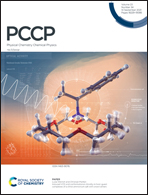Metallic VS2/graphene heterostructure as an ultra-high rate and high-specific capacity anode material for Li/Na-ion batteries†
Abstract
Graphene has been used as a conductive substrate to improve the electrochemical performance of layered VS2 as an anode material for lithium-ion batteries. However, there is still a lack of in-depth understanding of the synergistic effect between the layered VS2 and graphene, which contributes to the enhanced performance of Li/Na-ion batteries. In this work, using first-principles calculations, we have systematically studied the VS2/graphene heterostructure as an anode material for Li/Na-ion batteries. Our results show that the VS2/graphene heterostructure is a promising anode material with good structural stability, high adsorption strength, high stiffness, intrinsic metallic characteristic after Li/Na adsorption, high theoretical specific capacity, shallow averaged open-circuit voltage and ultra-low ion diffusion barriers. The diffusion barriers are found to be 0.03 eV (Li) and 0.08 eV (Na), superior to that of the widely studied heterostructure materials, which guarantees an extremely fast Li/Na diffusion rate during charge/discharge cycling. The anode overall open-circuit voltages for the Li/Na-ion batteries are calculated to be as low as 0.65 and 0.46 V, and the maximum theoretical storage capacity is 771 and 578 mA h g−1, respectively. The above results provide valuable insights into the experimental set-up of the VS2/graphene nanocomposite anode material for ultra-high rate and high-specific capacity Li/Na-ion batteries.



 Please wait while we load your content...
Please wait while we load your content...